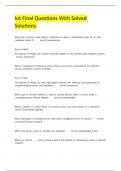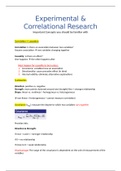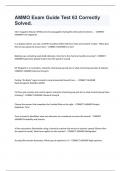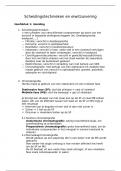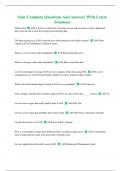Common Foreign and Security Policy (gemeenschappelijk buitenlands en
veiligheidsbeleid) (CFSP) overall policy.
WEEK 1:
Mocorini: First who made a 3 years strategy.
C (e) DSP: military part. (S)
Global strategy (P)
European Neighbour Policy (END). Sometimes part of military part.
Exam:
10 questions
4 case questions
6 knowledge questions
European Union:
Europea’s mission:
− Provide peace, prosperity and stability for its peoples;
− Overcome the divisions in the continent (bringing Europe together again);
− Ensure that its peoples can live in safety (safety and security);
− Meet the challenges of globalisation and preserve the diversity of the peoples of
Europe (identity and diversity in a globalised world);
− Uphold the values that Europeans share, such as sustainable development and a
sound environment, respect for human rights and the social market economy
(economic and social solidarity).
− Values
Ten historical steps of EU:
1. 1951: The European Coal and Steel Community is stablished by the six founding
members (treaty of Paris).
a. Belgium, Germany, France, Italy, Luxembourg and the Netherlands).
2. 1957: The Treaty of Rome establishes a common market (European Economic
Community (EEC)).
3. 1973: The Community expands to nice member states and develops its common
policies
4. 1979: The first direct elections to the European Parliament.
5. 1981: The first Mediterranean enlargement (Greece, Spain and Portugal joined).
6. 1993: Completion of the single market
7. 1993: The Treaty of Maastricht establishes the European Union
8. 1995: The EU expands to 15 members.
9. 2002: Euro notes and coins are introduced
10. 2004: Ten more countries join the Union.
Enlargement and neighbourhood policy:
• The European Union is open to any European country that fulfils the democratic,
political and economic criteria for membership.
, • Following several enlargements, the EU has increased from six to 27 members.
Several other countries are candidates to join.
• Each treaty admitting a new member requires the unanimous approval of all member
states. In addition, in advance of each new enlargement, the EU will assess its
capacity to absorb the new member(s) and the ability of its institutions to continue
to function properly.
• The successive enlargements have strengthened democracy, made Europe more
secure and increased its potential for trade and economic growth.
How does the EU works?
− The Council of Ministers of the European Union, which represents the member
states, is the EU’s main decision-taking body. When it meets at Heads of State or
Government level, it becomes the European Council whose role is to provide the EU
with political impetus on key issues.
− The European Parliament, which represents the people, shares legislative and
budgetary power with the Council of the European Union.
− The European Commission, which represents the common interest of the EU, is the
main executive body. It has the right to propose legislation and ensures that EU
policies are properly implemented.
Others:
• The Court of Justice
• The Court of Auditors
• The European Economic and Social Committee
• The committee of the Regions
• The European Investment Bank
• The European Central Bank
What does the EU do?
• The European Union acts in a wide range of policy areas — economic, social,
regulatory and financial — where its action is beneficial to the member states. These
include:
o solidarity policies (also known as cohesion policies) in regional, agricultural
and social affairs;
o innovation policies, which bring state-of-the-art technologies to fields such as
environmental protection, research and development (R&D) and energy.
• The Union funds these policies through an annual budget of more than €120 billion,
which is largely paid for by the member states.
• It represents a small proportion of the EU’s collective wealth (a maximum of 1.24 %
of the combined gross national income of all member states).
Single market:
• The single market is one of the European Union’s greatest achievements. Restrictions
between member countries on trade and free competition have gradually been
eliminated, with the result that standards of living have increased.
• The single market has not yet become a single economic area. Some sectors of the
economy (public services) are still subject to national laws.
, • The individual EU countries still largely have the responsibility for taxation and social
welfare.
• The single market is supported by a number of related policies put in place by the EU
over the years. They help ensure that market liberalisation benefits as many
businesses and consumers as possible.
Economic and monetary union (THE EURO)
• The euro is the single currency of the European Union. Twelve of the then 15
countries adopted it for non-cash transactions from 1999 and for all payments in
2002 when euro notes and coins were issued.
• Three countries (Denmark, Sweden and the United Kingdom) did not participate in
this monetary union.
• The new member countries are getting ready to enter the euro area as soon as they
fulfil the necessary criteria.
• In parallel with the objective of monetary stability, which is the responsibility of the
European Central Bank, the member states are committed to higher growth and
economic convergence.
A citizens’ Europe:
• Thanks to the European Union, citizens of member countries can travel, live and work
anywhere in Europe.
• In daily life, the EU encourages and funds programmes to bring citizens closer
together, particularly in the fields of education and culture.
• A feeling of belonging to the European Union will develop only gradually, through its
tangible achievements and successes.
• Some symbols that represent a shared European identity already exist. The most
prominent is the single currency, but there are also the EU flag and anthem.
The EU on the world stage:
• The EU has more influence on the world stage when it speaks with a single voice in
international affairs. Trade negotiations are a good example of this.
• In the area of defence, each country remains sovereign, whether a member of NATO
or neutral. However, the EU member states are developing military cooperation for
peacekeeping missions.
• For reasons of history and geographic proximity, the southern Mediterranean and
Africa are areas to which the EU gives close attention (development aid policies,
trade preferences, food aid and human rights).
Ministry of Foreign Affairs (global summary):
In sum, peace and freedom through cooperation is a fine ideal. The reality, however, can be
challenging. The Netherlands wants a modern, effective and robust European Union, a Union
of results and values. A future-proof Union that renders account. A Union that both gives
and takes responsibility. The European Union is not a given; that much is now clear. It is a
project that requires maintenance and engagement by strong member states.
, A decisive European approach to migration through managing and controlling irregular
migration.
A forward-looking agenda for a secure Europe. (terrorists). The terrorist threat in Europe
remains substantial. Another key development in the area of security is increasing
digitalisation.
A strong and sustainable European economy that offers protection. The EU’s primary role
lies in promoting sustainable economic growth, strengthening competitiveness, and creating
jobs and prosperity.
An effective European climate policy. (zonnepanelen).
An EU that defends its interests and values in the wider world. To deliver results on our
priorities – migration, security, a strong economy and climate – vigorous external action by
the Union is a basic necessity.
An effective European Union calls for properly functioning institutions and strong member
states. To achieve these priorities and deliver practical results, the performance of both the
EU institutions and the member states needs to meet certain requirements. Particularly in a
year of drastic change, a focus on the EU’s functioning will be vital. While keeping to the
framework of the current treaties, we need to see what can and must be improved.
The Netherlands’ position in a changing European Union. Realising the Netherlands’
ambition of an EU that delivers on migration, security, the single market and climate policy
while maintaining a strong global position, demands active Dutch effort in Brussels and all
the European capitals. An active Dutch stance is needed in the EU, both to achieve the
Netherlands’ objectives at European level and to resist the developments that the
government considers less positive. To achieve results, the Netherlands needs the other
member states. This means working together with like-minded countries and – at least as
important – building bridges where possible with parties that hold different positions.
‘European integration as a peace project’ (idk what for summary it is)
In 2012, the Norwegian Nobel Committee awarded the Nobel Peace Prize to the European
Union. When the EU was awarded the Nobel Peace Prize, it was in bad shape. The still
lingering Eurozone-debt crisis was at its height. The Norwegian Prize Committee (2012)
acknowledged the EU’s problems, but con- cluded that its contribution to peace was more
important. Peace, for the committee, was thus more than the absence of war, but also the
reduced prospect of conflict.
Arguably, the Norwegian Prize Committee was making the case that the EU was a victim of
its own success. Because war among its members is now ‘unthinkable’, its role in preventing
conflict is no longer important.
Since the award of the Peace Prize, the security situation in Europe has changed dramatically
for the worse (terrorist’s attacks).
The process of European integration has many elements in common with the liberal theory
of peace articulated by the US President Woodrow Wilson.
veiligheidsbeleid) (CFSP) overall policy.
WEEK 1:
Mocorini: First who made a 3 years strategy.
C (e) DSP: military part. (S)
Global strategy (P)
European Neighbour Policy (END). Sometimes part of military part.
Exam:
10 questions
4 case questions
6 knowledge questions
European Union:
Europea’s mission:
− Provide peace, prosperity and stability for its peoples;
− Overcome the divisions in the continent (bringing Europe together again);
− Ensure that its peoples can live in safety (safety and security);
− Meet the challenges of globalisation and preserve the diversity of the peoples of
Europe (identity and diversity in a globalised world);
− Uphold the values that Europeans share, such as sustainable development and a
sound environment, respect for human rights and the social market economy
(economic and social solidarity).
− Values
Ten historical steps of EU:
1. 1951: The European Coal and Steel Community is stablished by the six founding
members (treaty of Paris).
a. Belgium, Germany, France, Italy, Luxembourg and the Netherlands).
2. 1957: The Treaty of Rome establishes a common market (European Economic
Community (EEC)).
3. 1973: The Community expands to nice member states and develops its common
policies
4. 1979: The first direct elections to the European Parliament.
5. 1981: The first Mediterranean enlargement (Greece, Spain and Portugal joined).
6. 1993: Completion of the single market
7. 1993: The Treaty of Maastricht establishes the European Union
8. 1995: The EU expands to 15 members.
9. 2002: Euro notes and coins are introduced
10. 2004: Ten more countries join the Union.
Enlargement and neighbourhood policy:
• The European Union is open to any European country that fulfils the democratic,
political and economic criteria for membership.
, • Following several enlargements, the EU has increased from six to 27 members.
Several other countries are candidates to join.
• Each treaty admitting a new member requires the unanimous approval of all member
states. In addition, in advance of each new enlargement, the EU will assess its
capacity to absorb the new member(s) and the ability of its institutions to continue
to function properly.
• The successive enlargements have strengthened democracy, made Europe more
secure and increased its potential for trade and economic growth.
How does the EU works?
− The Council of Ministers of the European Union, which represents the member
states, is the EU’s main decision-taking body. When it meets at Heads of State or
Government level, it becomes the European Council whose role is to provide the EU
with political impetus on key issues.
− The European Parliament, which represents the people, shares legislative and
budgetary power with the Council of the European Union.
− The European Commission, which represents the common interest of the EU, is the
main executive body. It has the right to propose legislation and ensures that EU
policies are properly implemented.
Others:
• The Court of Justice
• The Court of Auditors
• The European Economic and Social Committee
• The committee of the Regions
• The European Investment Bank
• The European Central Bank
What does the EU do?
• The European Union acts in a wide range of policy areas — economic, social,
regulatory and financial — where its action is beneficial to the member states. These
include:
o solidarity policies (also known as cohesion policies) in regional, agricultural
and social affairs;
o innovation policies, which bring state-of-the-art technologies to fields such as
environmental protection, research and development (R&D) and energy.
• The Union funds these policies through an annual budget of more than €120 billion,
which is largely paid for by the member states.
• It represents a small proportion of the EU’s collective wealth (a maximum of 1.24 %
of the combined gross national income of all member states).
Single market:
• The single market is one of the European Union’s greatest achievements. Restrictions
between member countries on trade and free competition have gradually been
eliminated, with the result that standards of living have increased.
• The single market has not yet become a single economic area. Some sectors of the
economy (public services) are still subject to national laws.
, • The individual EU countries still largely have the responsibility for taxation and social
welfare.
• The single market is supported by a number of related policies put in place by the EU
over the years. They help ensure that market liberalisation benefits as many
businesses and consumers as possible.
Economic and monetary union (THE EURO)
• The euro is the single currency of the European Union. Twelve of the then 15
countries adopted it for non-cash transactions from 1999 and for all payments in
2002 when euro notes and coins were issued.
• Three countries (Denmark, Sweden and the United Kingdom) did not participate in
this monetary union.
• The new member countries are getting ready to enter the euro area as soon as they
fulfil the necessary criteria.
• In parallel with the objective of monetary stability, which is the responsibility of the
European Central Bank, the member states are committed to higher growth and
economic convergence.
A citizens’ Europe:
• Thanks to the European Union, citizens of member countries can travel, live and work
anywhere in Europe.
• In daily life, the EU encourages and funds programmes to bring citizens closer
together, particularly in the fields of education and culture.
• A feeling of belonging to the European Union will develop only gradually, through its
tangible achievements and successes.
• Some symbols that represent a shared European identity already exist. The most
prominent is the single currency, but there are also the EU flag and anthem.
The EU on the world stage:
• The EU has more influence on the world stage when it speaks with a single voice in
international affairs. Trade negotiations are a good example of this.
• In the area of defence, each country remains sovereign, whether a member of NATO
or neutral. However, the EU member states are developing military cooperation for
peacekeeping missions.
• For reasons of history and geographic proximity, the southern Mediterranean and
Africa are areas to which the EU gives close attention (development aid policies,
trade preferences, food aid and human rights).
Ministry of Foreign Affairs (global summary):
In sum, peace and freedom through cooperation is a fine ideal. The reality, however, can be
challenging. The Netherlands wants a modern, effective and robust European Union, a Union
of results and values. A future-proof Union that renders account. A Union that both gives
and takes responsibility. The European Union is not a given; that much is now clear. It is a
project that requires maintenance and engagement by strong member states.
, A decisive European approach to migration through managing and controlling irregular
migration.
A forward-looking agenda for a secure Europe. (terrorists). The terrorist threat in Europe
remains substantial. Another key development in the area of security is increasing
digitalisation.
A strong and sustainable European economy that offers protection. The EU’s primary role
lies in promoting sustainable economic growth, strengthening competitiveness, and creating
jobs and prosperity.
An effective European climate policy. (zonnepanelen).
An EU that defends its interests and values in the wider world. To deliver results on our
priorities – migration, security, a strong economy and climate – vigorous external action by
the Union is a basic necessity.
An effective European Union calls for properly functioning institutions and strong member
states. To achieve these priorities and deliver practical results, the performance of both the
EU institutions and the member states needs to meet certain requirements. Particularly in a
year of drastic change, a focus on the EU’s functioning will be vital. While keeping to the
framework of the current treaties, we need to see what can and must be improved.
The Netherlands’ position in a changing European Union. Realising the Netherlands’
ambition of an EU that delivers on migration, security, the single market and climate policy
while maintaining a strong global position, demands active Dutch effort in Brussels and all
the European capitals. An active Dutch stance is needed in the EU, both to achieve the
Netherlands’ objectives at European level and to resist the developments that the
government considers less positive. To achieve results, the Netherlands needs the other
member states. This means working together with like-minded countries and – at least as
important – building bridges where possible with parties that hold different positions.
‘European integration as a peace project’ (idk what for summary it is)
In 2012, the Norwegian Nobel Committee awarded the Nobel Peace Prize to the European
Union. When the EU was awarded the Nobel Peace Prize, it was in bad shape. The still
lingering Eurozone-debt crisis was at its height. The Norwegian Prize Committee (2012)
acknowledged the EU’s problems, but con- cluded that its contribution to peace was more
important. Peace, for the committee, was thus more than the absence of war, but also the
reduced prospect of conflict.
Arguably, the Norwegian Prize Committee was making the case that the EU was a victim of
its own success. Because war among its members is now ‘unthinkable’, its role in preventing
conflict is no longer important.
Since the award of the Peace Prize, the security situation in Europe has changed dramatically
for the worse (terrorist’s attacks).
The process of European integration has many elements in common with the liberal theory
of peace articulated by the US President Woodrow Wilson.



